Forrester’s West Coast Forum “Boost your Customer Experience to the Next Level” was held October 9th and 10th in Los Angeles. I attended as a correspondent for UX Magazine, while also taking in the conference content and conversations with my UX recruiter hat on.
A lot of great ideas were shared, and there were plenty of applicable takeaway nuggets to be digested and implemented. The overriding message of the conference seemed to be that tuning in to the voice of the customer, and adjusting the business to meet their needs either in interaction or end product, can provide exponential dividends for your business.
As Harley Manning, VP, Research Director at Forrester stated in his opening keynote: “Small adjustments to improve customer experience can have high returns.” Customer experience isn’t some buzzword that will be gone in a month. It truly has impact on your business’ bottom line and can be optimized when the voice of the customer is sought, heard, and integrated into the business model. Consumers today have a lot of options. Their tastes for experiences are becoming more discerning and really putting them at the center of your business model separates the average experience from the superb.
Before anyone could get the impression that a little magic snake oil and a few customer questionnaires are all that’s needed to create an impressive customer experience, Megan Burns, VP, Principal Analyst at Forrester was quick to make the point that there is only one path to differentiated customer experience. She used an Everest analogy to drive the point home: customer experience maturity is something most companies dream of, but, like summiting Everest, very few make it to the top.
We were informed that there are four steps that companies must go through to reach CX maturity: Repair, Elevate, Optimize, and Differentiate—no skipping steps and no breezing through. Just as climbers have to stay at the summit of Everest for 4-6 weeks to acclimate to the new elevation, companies must make time for changes and improvements in their customer experience processes to gel and become part of their company culture.
With every stage in the process of differentiation, customer research is absolutely critical. “The voice of the customer has to rule if you want to differentiate,” Clyde Guinn, President of Days Inn, said. Clyde’s presentation on how Days Inn—a company within the price sensitive and competitive market of economical hotels—took stock of their customers’ view of them, lent useful insight.
Engaged employees have direct impact on positive CX and, therefore, revenue
It was only through really understanding what their customers valued in their stay, that Days Inn was able to realize they needed to realign their offerings to meet those needs. They were quick to learn that their breakfast offering was not only not visually appealing, its high sugar and carb content was turning people off.
One of the best quotes of the conference came from Clyde in relation to the breakfast breakthrough: “[We realized] we were spending $34 million a year to piss off our customers.” Customer research not only allows a company to realize where their investments are falling short, it also provides insight into where to better allocate those resources.
By embracing the research phase of the design process you’ll be able to put yourself into your customers’ shoes. As Kerry Bodine, VP, Principal Analyst with Forrester shared in her presentation, Design Experience From the Outside In, design is a problem-solving process as well as a mindset.
“Terrible ideas provide fodder for better and better ideas,” she said. With the prototyping phase, getting it 50% there the first time is a good target. Shoot for another 20% the second time and, hopefully, another 30% further with the third iteration. Prototypes and customer journeys help to visualize customer experiences. “Get visual!” Bodine said. “Customer experience innovation doesn’t happen in an excel spreadsheet.”
Company culture was another theme touched on frequently across various presentations. Allowing employees to let their personalities shine improves customer experience, both in call center settings (as described by Harit Talwar of Discover Financial Services) as well as in service industries (Kelly Bodine’s 2 Ovens case study). With the shocking statistic that 70% of American employees do not feel engaged at work (Samuel Stern, Senior Analyst at Forrester) added to equally disturbing statistic that 79% of organizations don’t train their employees on the targeted customer experience, its no surprise that 61% of companies are providing ok to very poor customer experiences across industries (Megan Burns).
Companies need to not only look at how to provide the best customer experiences, but also how they engage their employees to deliver the targeted customer experience. Additional data drives it home: profit margins for companies with “sustainable engagement of employees” is 17.5% more than companies with “low employee engagement” (27.4% versus 9.9%). Stern made the great suggestion of leveraging company rituals and conversations to reinforce company values and goals. Reinforcing the value of engaged employees can have a positive impact downstream.
It was amusing to hear the figure that 58% of companies watch competitors and copy their innovation, but imitation does not make innovation. Companies need to triangulate where consumer needs meet their business model and brand, as Bodine explained, this is the intersection where innovation happens. It was mentioned several ways that true customer experience differentiation happens when it’s integrated across the various customer touchpoints: “This is a competitive advantage that is hard for your competitors to clone,” noted Talwar of Discover. When faced with the choice of pursuing relevance or coolness, Talwar advises that we choose relevance. Being cool with no relevance won’t get you anywhere.
As someone who works closely with product and service companies to define team composition it was exciting to speak with several people who have been recently charged with pioneering and leading CX initiatives in their companies. Many folks and the companies they work for are relatively new to CX, and this conference was a great place to gain insights, success stories, and inspirations for establishing and delivering great customer experiences. Its great to see customer experience really starting to take hold within the business models, and to feel the momentum of companies embracing CX as a key component to revenue and innovation.
I heard positive feedback from attendees on their experience with the conference, especially regarding the morning keynote sessions. These sessions were especially inspiring as there were real world business examples of how a shift toward customer-centric business practices had immense ROI, even in the highly competitive hotel space and the “negative services” of windshield replacement.
After the keynote speeches attendees had the opportunity to select from three simultaneous “track presentations” depending on their businesses level of maturity in the CX space. The comments from attendees on the tracked presentations were also positive, though there were some lamentations that they were a bit too high level to really glean much in implementable value. Though, the case can be made that through sharing the high-level view of customer journey mapping, for example, a company can get a feel for what the full process will entail and then invest more time in specific parts of the process.
I left the conference with my wheels turning about how I could apply customer research and journey mapping to my role within the career development and recruitment space. I could absolutely create personas for the clients and candidates I work with, and analyze where in the customer journey I can focus on improving the experience for those I work for and with. These principles are just as applicable to teams of one as they are to organizations of thousands.
Here are four key takeaways that have stayed with me following the conference:
- Customer research is critical
- Increased revenue and ROI can be generated from positive customer experience
- Engaged employees have direct impact on positive CX and, therefore, revenue
- The whole ecosystem and customer journey should be addressed when creating and implementing CX initiatives
If you were at the conference please share your takeaways. Are there initiatives you’re planning to implement right away or do you have to gain buy-in first across your management team? If you have insights or comments about CX outside of the Forrester forum, I’d love to hear them as well.








